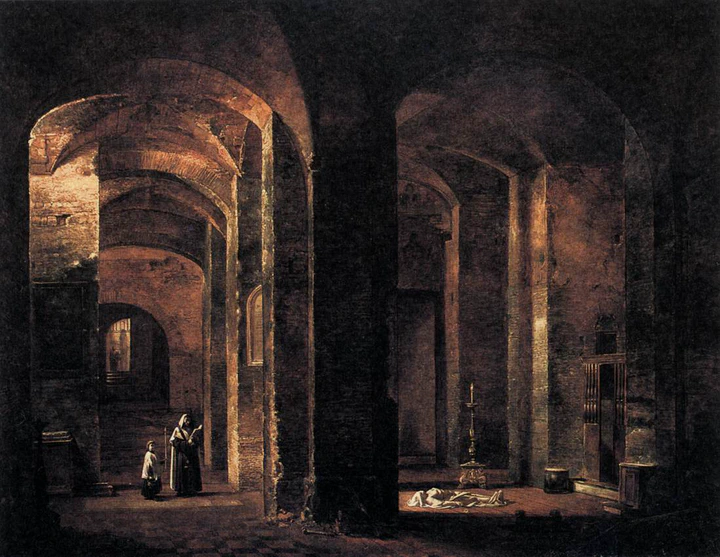Burial Customs

Artwork: François-Marius Granet, “Crypt of San Martino ai Monti, Rome.”
General resources
“Burying the Dead: Catholic Funerals.” Fish Eaters. https://www.fisheaters.com/funerals.html.
Menestrier, Claude-François, -. Des Decorations Funebres : Ou Il Est Amplement Traité Des Tentures, Des Lumieres, Des Mausolées, Catafalques, Inscriptions & Autres Ornemens Funebres; Avec Tout Ce Qui S’est Fait De Plus Considerable Depuis Plus D’un Siecle, Pour Les Papes, Empereurs, Rois, Reines, Cardinaux, Princes, Prelats, Sçavans & Personnes Illustres En Naissance, Vertu & Dignité. Edited by Robert-Jean-Baptiste de La Caille and Robert Pepie. À Paris: Chez R.J.B. de la Caille, R. Pepie. 1683.
Purgatorial Societies
Purgatorial societies or confraternities exist to offer Masses and pray for the souls in Purgatory. A similar practice is that of a chantry, a fund and/or chapel which a donor reserves for Mass to be said for their soul.
For more information, consider contacting your local churches, diocese, or traditional orders to see if they have preexisting purgatorial soceties.
Kreider, Alan. English chantries : the road to dissolution. Cambridge, Mass.: Harvard University Press, 1979. https://archive.org/details/englishchantries0000krei.
The manual of the Bona Mors confraternity: Association for a Happy Death. New York: Apostleship of Prayer, 1896. https://archive.org/details/manualofbonamors00unse/page/n3/mode/2up.
Purgatorian Archconfraternity. http://www.archconfraternity.com/.
Catholic Church. “The Golden Book of the Confraternities.” (1854). https://archive.org/details/GoldenBookOfTheConfraternities/page/n243/mode/2up.
Queloz, Brixious, and Michael Müller. Purgatorian Consoler : A Manual of Prayers Containing a Selection of Devotional Exercises, Originally Prepared for the Use of the Members of the Purgatorian Arch-Confraternity, Enlarged and Adapted to General Use. Baltimore, MD: J. Murphy, 1868. https://archive.org/details/purgatorianconso00queluoft.
Müller, Michael. Purgatory and the Purgatorian Society. New York, 1891.
Gregory, William L. S. “Remarks on Purgatorian Penny Societies.” T. Johnstone (1815?). https://digital.lib.uiowa.edu/islandora/object/ui%3Atestbollinger5_250.
Muret, Pierre, approximately -approximately . Rites of Funeral, Ancient and Modern, in Use through the Known World. Edited by P. Lorrain and Marcus Minucius Felix. London: Printed for R. Royston, 1683.
Lambing, Andrew Arnold. The Sacramentals of the Holy Catholic Church. New York: Benzinger Bros., 1892. https://archive.org/details/SacramentalsOfTheHolyCatholicChurch/page/n3/mode/2up.
Devine, Arthur. The Sacraments Explained … : With an Introductory Treatise on Grace. 1899. https://archive.org/details/sacramentsexplai00deviuoft.
Caskets
The Trappist Monastery of New Melleray Abbey make hand-crafted caskets and urns for adults. They provide caskets for children at no cost.
Trappist Caskets: From the Monks of New Melleray Abbey. https://trappistcaskets.com/.
Chantries
Ferguson, John. “Chantry and Chantry Priests.” Chap. XI In Ecclesia Antiqua, or, the History of an Ancient Church (St. Michael’s, Linlithgow), xxiii, 357 p., [14] leaves of plates. Edinburgh: Oliver & Boyd, 1905.
“Photos of Chantries Held at the Getty Museum.” http://www.getty.edu/art/collection/search/?view=grid&query=YToyOntzOjU6InF1ZXJ5IjtzOjc6ImNoYW50cnkiO3M6NDoic29ydCI7czo2OiItc2NvcmUiO30%3D.
Habsburg burials
Some of the most detailed descriptions we have of burial customs come from Catholic royal families. A notable example is the ‘knocking ceremony’ from the Habsburg family, as the deceased is brought to the Capuchin Church that houses the Imperial Crypt in Vienna. It has been seen most recently in the funeral of Otto von Habsburg in 2011.
The Grand Chamberlain knocks three times with a silver cane on the door of the Capuchin convent which contains the Imperial crypt. The Capuchin porter asks: “Who is there?”
The Grand Chamberlain proclaims the name and titles of the deceased Hapsburg emperor: “I am (Name) … Emperor of Austria, Apostolic King of Hungary, King of Bohemia, Dalmatia, Croatia, Slavonia, Galicia, Lodomeria, of Illyria, and King of Jerusalem, Archduke of Austria, Grand Duke of Tuscany and Cracow, Duke of Lorraine , Salzburg, STIR, Carinthia, of Carniola and Bukovina, Grand Prince of Transylvania, Margrave of Moravia, Duke of Upper Silesia, Lower Silesia, of Modena, Parma, Piacenza and Guastalla, of Auschwitz and Zator of Ticino, Friuli, Ragusa and Zara, Prince of Conde-Hapsburg and Tyrol, of Kyburg, in Goritz and Gradisca, Prince of Trent and Brixen, Margrave of Upper and Lower Lusatia and Istria, Earl of Hohenembs of Feldkirch of Brigance, in Sonnenberg, Lord of Trieste, of Cattaro and Marche, Great Voivode of Serbia, etc.” Upon hearing this, the porter refuses to open the door and says: “I do not know you.”
The Grand Chamberlain knocks on the door again and in answer to the porter’s question “Who is there?” gives just the name of the deceased prince: “I am (Name) … His Majesty the Emperor and the King.” The porter again refuses admission: “I do not know you.”
For a third time, the Grand Chamberlain knocks on the door and the porter asks anew, “Who is there?” This time, the Grand Chamberlain simply says: “I am (Name)… a poor mortal and a sinner.” To this, the Capuchin friar responds: “Come in.”
“The Traditional Burial Ceremony of a Hapsburg Prince.” Nobility.org, Updated July 11, 2011, https://nobility.org/2011/07/11/burial-protocol-austria/.
Ossuaries and catacombs
Ossuaries are resting places for remains, but are more famously known as “bone churches.” They are visually striking “memento mori"s, with walls, chandeliers, and even entire buildings made from bones.
“Ossuaries across Europe.” ArcGIS StoryMaps, Updated December 11, 2019, https://storymaps.arcgis.com/stories/41d40bc99d18465396675ac7d45a8121.
“Bone Houses: A Definitive Guide to the World’s Ossuaries.” Atlas Obscura. https://www.atlasobscura.com/lists/definitive-guide-to-ossuaries-crypts-and-catacombs.
Northcote, J. Spencer. The Roman Catacombs; or, Some Account of the Burial Places of the Early Christians in Rome. London: Catholic Publishing and Bookselling Co., Ltd., 1859. https://archive.org/details/romancatacombsor00nort.